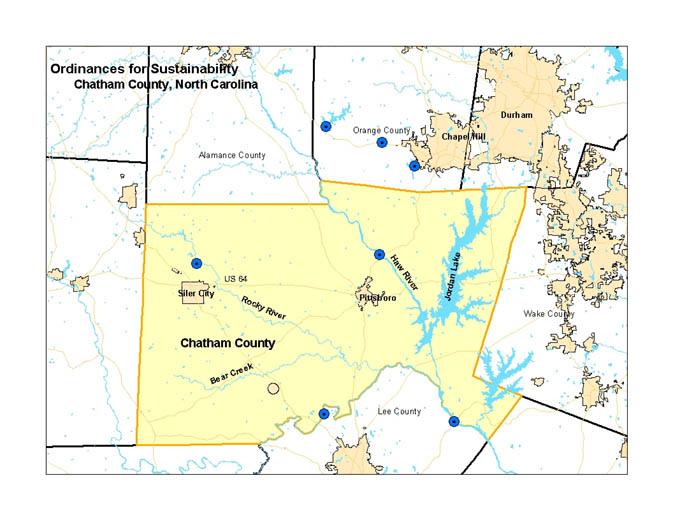Chatham County
Ordinances for Sustainability: Chatham County, North Carolina


Acting Entity: Chatham County Board of Commissioners
Contact Person: Keith Megginson
Cost:
Population Served: 50,000
Water Supply: Town of Pittsboro, City of Siler City, Lee County WTP, City of Sanford, Orange Water and Sewer Authority
PWS ID: 0319015, 0319010, 0353130, 0353010, 0368010
Helping Organizations:
· Chatham County
Funding Sources:
· None needed
Features:
· Chatham County ordinances predate the North Carolina Water Supply Watershed Protection requirements.
· The ordinances are voluntary action taken by Chatham County and provide the framework to meet the required subsequent state regulations.
· Ordinance development made use of Chatham County's Planning Board, which deals with water quality issues.
Summary: The Chatham County Board of Commissioners wanted to address sediment and other pollutant issues in the county's rivers as well as promote development in areas not adjacent to the county's rivers. To do this, the Planning Department of Chatham
County created a county ordinance that is more stringent than the current North Carolina model ordinance for watershed protection. Many of the watershed protection standards were set before the state's regulations were developed and Chatham County officials saw no need to relax Chatham County's standards.
Elements of the ordinance include:
1) The Chatham County ordinance applies to the entire county, outside the towns' limits and ETJ areas rather than only the state designated water supply watershed.
2) Buffer requirements include: 100-foot buffers for all rivers, 100-foot buffers required for all streams within half a mile of a river; 50-foot buffers required for streams not within half a mile of a river; and 50-foot buffers required for all intermittent streams. These buffers are designed specifically to lower sediment levels in the rivers.
3) Low density zoning, in this case meaning one house allowed per five acres, is required for half a mile on both sides of the rivers. Outside these corridors, where there is no public water and no public sewer system, the limit is one house per one and a half acres. This provides for less dense development along the rivers and requires that lots outside the public water and sewer service areas be of suitable size for well and septic systems.
These elements were added as amendments to the county's zoning ordinance. The amendment process requires public hearings for citizen input as well as review by the Planning Board. During this process, several local citizens who were property owners of land adjacent to rivers came forward in favor of the new zoning provisions. The Chatham County Planning Board is currently considering adding a further protection of water quality by increasing the width of all perennial stream buffers to 100 feet within areas that drain to Jordan Lake.


